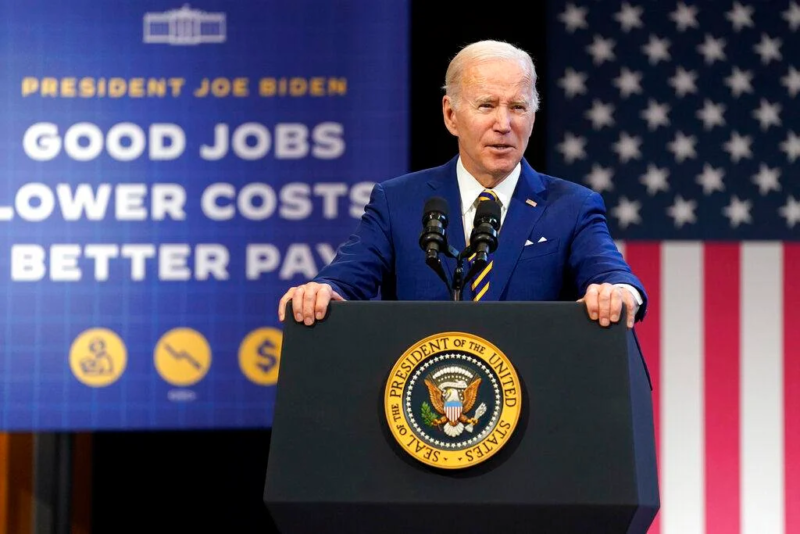
Now that President Joe Biden has announced he is seeking a second term in office, the most pressing question may be why? After all, every survey of public opinion finds the view of the U.S. economy is somewhere between dismal and dire.
What else would you expect in an era when perception drives the prevailing media narrative, feeding what seems like a never-ending doom loop of negativity when it comes to the economy? For all the griping, though, it’s worth remembering George Orwell’s timeless assertion that the hardest thing to see is right in front of one’s nose.
Start with the fact that the economy during Biden’s 27 months in the White House witnessed the greatest and fastest recovery of gross domestic product in modern times, an experience unmatched by any administration in at least half a century, according to data compiled by Bloomberg. That the U.S. has outperformed every major developed economy in recovering from a pandemic that claimed more than 1 million American lives should dispel any notion the 46th president inherited a situation that was anything remotely like his 12 post-World War II predecessors.
Growth in gross domestic product exceeding 3% is three times the average under Donald Trump, paving the way for record corporate earnings, the lowest corporate debt ratios, rising real incomes, surging homeowners’ equity in real estate to go along with the lowest mortgage delinquency rate on record, and household checking accounts flush with some $5 trillion of cash. And, no, your 401K has not suffered under Biden; the benchmark S&P 500 Index is up 23% since the November 2020 election.
For all that, the labor market is the real star. No president since Lyndon Johnson can match Biden’s record here. He has created the equivalent of six times more jobs than the last three Republican presidents combined. Some 824,000 jobs were created alone in the high-paying manufacturing sector amid the biggest commitment to rebuilding roads, airports, bridges and ports since the Eisenhower administration’s new national highways.
We have a jobless rate that is the lowest in a peacetime economy since World War II, according to data compiled by Bloomberg. Consider that unemployment is at all-time lows in 24 states and less than 3% in 21, according to data compiled by Bloomberg. The unemployment rate for Blacks has never been lower, nor has the gap with the overall jobless rate been narrower.
To be sure, the number of economists calling for a recession gets longer by the day as the Federal Reserve continues its unprecedented tightening of credit by raising interest rates to bring the rate of inflation back down to its 2% target. But while we wait — and wait — for the economic downturn that was deemed inevitable and imminent more than a year ago, the cost of living as measured by the Consumer Price Index has eased for nine consecutive months, to 4.99% in March from the recent high of 9.06% in June and is likely to drop to 3.2% by the end of this year, according to the average of 66 economist forecasts compiled by Bloomberg.
As cost pressures moderate, the economy is gaining momentum, with S&P Global’s flash composite purchasing managers index rising to 53.5 for April, the highest since May despite worries about an emerging “credit crunch” stemming from the collapse of Silicon Valley Bank. This is a direct repudiation of the economic doomsayers (who in their defense could still be proven right if Republicans in Congress refuse to raise the nation’s borrowing capacity that they increased three times with no trouble under Trump).
Biden will be hard pressed to build upon the unprecedented improvement in the federal budget deficit as a percentage of GDP — shrinking it to 5.52% from 15.6% — during his first two years in office as the effects of the pandemic abate and Republicans controlling the House oppose any new or higher taxes. But the deficit expanded every year under Trump and Democrats have a superior record pursuing balanced budgets: Presidents Bill Clinton and Jimmy Carter cut the deficit by 2.4 percentage points and 1.1 points in their first two years, respectively, while it expanded 1.1 points under Trump, 1.3 points under George H.W. Bush, 1.7 points under Ronald Reagan, 3.7 points under Barack Obama and 4.5 points under George W. Bush, according to data compiled by Bloomberg.
In addition to jobs, Biden also stands alone when it comes to the manufacturing revival, much of it in the Republican-controlled states whose senators and representatives voted against legislation enabling companies to spend billions of dollars on new projects as they benefit from government subsidies. The reason the U.S. is experiencing a manufacturing boom is because of the Infrastructure, Chips and Inflation Reduction Acts voted into law during his first two years in office. Bloomberg News reported last week that renewable power developers alone have already invested more than $150 billion in large clean energy projects over just eight months, surpassing the total over the five preceding years.
Sure, there is much to criticize the Biden administration about, from the crisis at the southern border to the chaotic pullout from Afghanistan and other foreign policy missteps. But as political consultant James Carville will tell you, all those things are just a sideshow to the economy when it comes elections. The key for Biden is finding a way to get voters to ignore perception and focus on reality.









